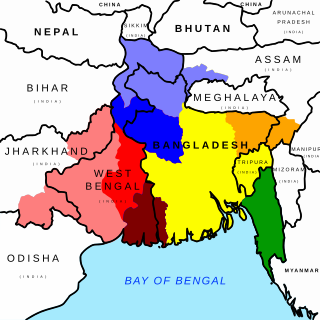
Bishnupur is a city and a municipality in Bankura district, West Bengal, India. It has terracotta temples built by the Malla rulers, historic Radha Krishna temples built during 1600–1800 CE and the Baluchari sarees. In 1997 the temples of Bishnupur were placed on the UNESCO World Heritage Site's Tentative list.

History of Bankura district refers to the history of the present Bankura district in the Indian state of West Bengal. Historically, the region was under the realm of Rarh in ancient Bengal.

Mallabhum was the kingdom ruled by the Malla kings of Bishnupur, primarily in the present Bankura district in Indian state of West Bengal.
Culture of Bankura district refers to the culture of Bankura district in the Indian state of West Bengal.
Hambir Malla Dev was the forty-ninth king of Mallabhum. He ruled from 1565 to 1620 AD.

The Rasmancha is a historical temple located at Bishnupur, Bankura district, West Bengal, India.

Kalipada Singha Thakur was the last King of Malla dynasty of Bishnupur. He became King of Mallabhum in the year 1930 C.E.
Dhari Malla was the forty-eight king of the Mallabhum. He ruled from 1554 to 1565 CE.
Dhari Hambir Malla Dev, also known as Dhari Hambeera was the fiftieth king of the Mallabhum. He ruled from 1620 to 1626 CE.
Raghunath Singha Dev II was the fifty-fourth king of the Mallabhum. He ruled from 1702 to 1712.
Durjan Singha Dev was the fifty-third king of the Mallabhum. He ruled from 1682 to 1702.
Gopal Singha Dev I was the fifty-fifth Raja of Mallabhum. He ruled from 1712 to 1748.

Bir Singha Dev was the fifty-second king of the Mallabhum. He ruled from 1656 to 1682 CE.
Gopal Singha Dev II was the fifty-eighth king of the Mallabhum. He ruled from 1809 to 1876 CE.

Bengal temple architecture also known as Malla dynasty architecture is about temple styles developed and used in Bengal, particularly the chala, ratna and dalan temples.

Radh Bengal is a region in West Bengal also known as the Temple Town. This region consists of arrays of temples in varying sizes and devoted to different gods and goddess but the common thread unifying this group is that the temples are constructed in terracotta. The region consists of following districts Birbhum, Bankura, Burdwan, Purulia and parts of Murshidabad. The construction style originated in 16th century and lasted till the 19th century. This period is also referred as a golden age of temple in West Bengal. Reason for development of this construction technique was the rich red laterite soil of the region and lack of construction worthy stone. The skill of creating daily objects from like vessels, pottery, seal and toys evolved into a construction technique in the time of need. These temples are baked terracotta panels or bricks. This particular style spread outside the present day West Bengal as well, to Jharkhand, Bihar, Assam and Tripura.

Malleswar Temple also known as Mallesvara Temple, is a Shiva temple in Bishnupur in Indian state of West Bengal. This temple was dedicated to Shiva.

Madan Gopal Temple also known as Pancha-ratna temple, is a Krishna temple in Bishnupur in the Indian state of West Bengal. In this temple, the Hindu God Krishna is worshiped.

Jor Mandir also known as group of temples, Located in Bishnupur in Indian state of West Bengal.

Kalachand Temple, Located in Bishnupur in Indian state of West Bengal.





























